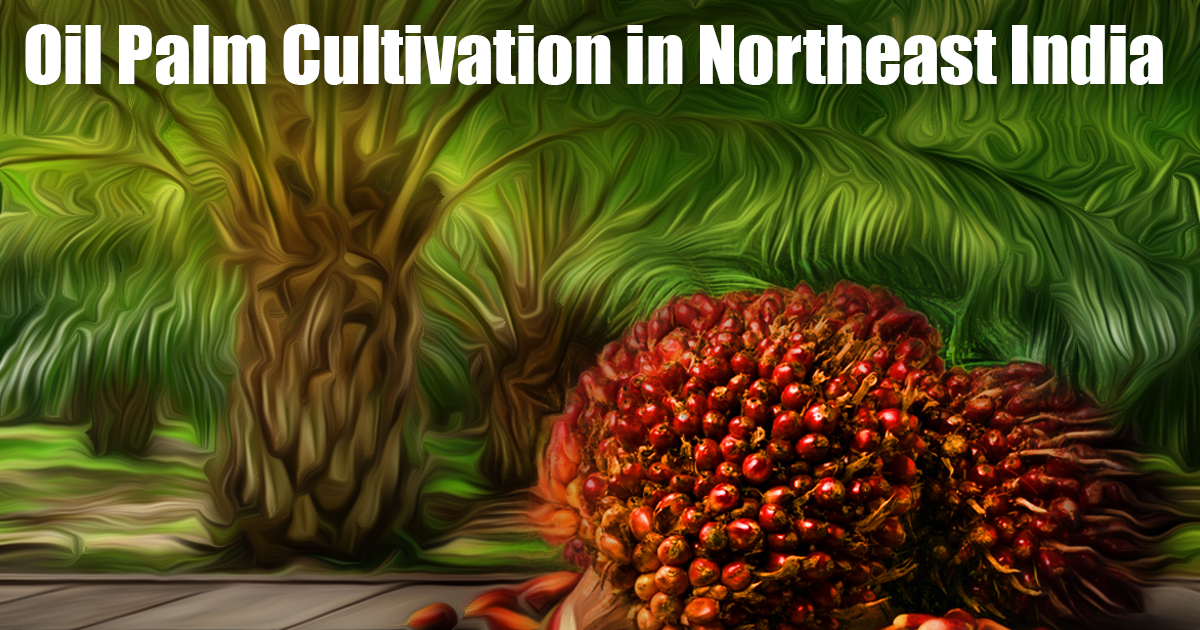
Context: The promotion of large-scale monoculture oil palm plantations in Northeast India is raising concerns due to its environmental impacts and the threats it poses to the economic and social security of local communities.
What is Oil Palm?
- Global Importance: Oil palm is the world’s most significant oil crop, meeting around 40% of global demand for vegetable oil.
- Origin and Spread: Originally from West Africa, oil palm is now extensively cultivated, particularly in Southeast Asia.
- Types of Oils: The crop yields two types of oils:
- Palm Oil: Extracted from the fleshy mesocarp of the fruit, containing 45-55% oil.
- Palm Kernel Oil: Sourced from the kernel of the seed, and is a rich source of lauric oil.
- Major Producers: Indonesia and Malaysia are the leading producers of palm oil, with Malaysia being the second-largest globally.
- Applications: Palm oil is versatile, used in food products, cosmetics, pharmaceuticals, biofuels, and bio-lubricants.
- Health Benefits: Palm oil is packed with nutrients like tocotrienols, which support heart health and offer antioxidant properties. It is a great source of fatty acids, contains no trans fats, and has lower levels of omega-6, making it beneficial for conditions like Alzheimer’s and dementia.
Status of Oil Palm in India:
- Dependence on Imports: India is the largest importer of edible oils globally, with palm oil accounting for more than 50% of its edible oil imports.
- Economic Value: In 2021, India’s palm oil imports were valued at approximately $8.63 billion.
India’s Measures to Boost Oil Palm Cultivation:
- Need for Domestic Production: With major producers like Malaysia and Indonesia planning to reduce production for environmental reasons, India sees the need to increase local cultivation.
- National Mission on Edible Oils-Oil Palm (NMEO-OP): Launched in 2021, this Centrally Sponsored Scheme focuses on expanding oil palm cultivation, particularly in the Northeast and the Andaman and Nicobar Islands.
- Goals:
- Expand oil palm cultivation to one million hectares by 2025-26.
- Increase crude palm oil production from 27,000 tonnes in 2019-20 to 1.12 million tonnes by 2025-26.
- More than 50% of this expansion (328,000 hectares) is planned in the northeastern states, based on a 2020 assessment by the Indian Institute of Oil Palm Research.
- Early Adoption: Mizoram was the first state in the Northeast to initiate oil palm cultivation.
Challenges in Northeast India:
- Capital Intensive: Establishing oil palm plantations requires significant investment.
- Land Availability: Oil palm cultivation demands large, contiguous tracts of land, which are scarce in the region.
- Resource-Intensive: The crop requires substantial water and nutrient inputs, with optimal growth needing evenly distributed rainfall of 150mm per month or 2500-4000mm annually. However, rainfall distribution in India is uneven.
- Long Gestation Period: Oil palm trees take 4-5 years to begin bearing fruit, with a productive lifespan of 20-25 years.
- Logistical Issues: The region’s rugged terrain, remote locations, and inadequate road networks pose significant challenges for transporting produce.
- Processing Constraints: The absence of nearby oil mills, coupled with the perishable nature of oil palm (which must be processed within 24-48 hours of harvesting), complicates operations.
- Procurement Problems: Delays in procurement and reductions in purchase prices based on quality discourage farmers.
- Natural Disasters: Converting forests into plantations increases vulnerability to landslides.
- Subsidy Delays: Farmers often face delays, reductions, or complete stoppages in the payment of government subsidies.
- Resistance from States: Sikkim and Meghalaya have chosen not to pursue oil palm cultivation due to these challenges.
Impacts in Northeast India:
- Social Disruption: In the Northeast, where land is often communally owned and used for subsistence farming, oil palm plantations can disrupt land tenure and ownership patterns. The capture of common lands by local elites, particularly in Arunachal Pradesh, exacerbates the marginalization of poorer communities, potentially leading to social unrest and conflict.
- Environmental Consequences: The large-scale conversion of forests to plantations is degrading soil health, depleting groundwater resources, and disrupting local ecosystems.
- Economic Impacts: Rising labor costs and the reduction of employment opportunities for women, who traditionally work in subsistence farming, are notable economic challenges. Additionally, the production of crude palm oil generates significant biowaste, including approximately 4 tonnes of dry palm biomass and 3.5 tonnes of palm oil mill effluent for every tonne of oil produced.
Looking Ahead:
- Environmental Considerations: It is crucial to factor in local environmental conditions before converting forests into plantations.
- Learning from the Past: The impacts of tea and coffee plantations in the region should be considered to avoid repeating past mistakes.
- Social Safeguards: Ensuring fair labor practices and protecting social welfare are essential to mitigating the adverse effects of oil palm cultivation in the Northeast.




